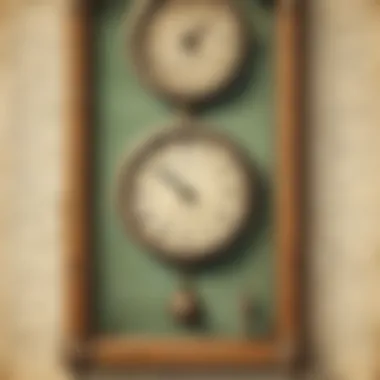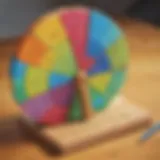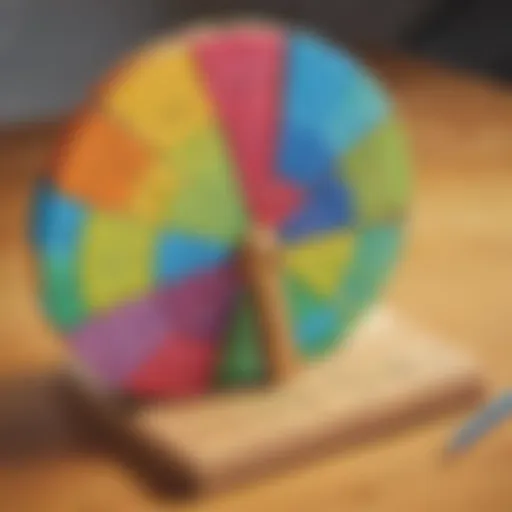Unraveling the Mysteries of Time for Young Minds: A Journey of Temporal Discovery


Creative Activities
In this section, we will explore exciting craft ideas that elementary school children can easily recreate to deepen their understanding of the concept of time. From constructing paper sundials to crafting their own working clocks using simple materials like paper plates and disposable cups, these hands-on activities will not only engage young learners but also enhance their comprehension of time measurement. Step-by-step guides accompany each craft idea, providing clear instructions for children to follow with ease. The educational value of these creative activities lies in fostering practical skills and spatial reasoning, essential for grasping abstract concepts like time.
Fun Quizzes
Engage and challenge elementary school children with fun quizzes designed to reinforce their learning about the concept of time. These quizzes cover topics such as telling time, elapsed time, and the measurement of time units. Question types range from multiple choice to fill-in-the-blank, ensuring varied engagement and assessing different aspects of time comprehension. By participating in these quizzes, children not only test their knowledge but also strengthen their understanding of temporal concepts, making learning interactive and enjoyable. The quizzes on Elem Fun serve as a valuable tool for knowledge reinforcement and retention.
Fact-Based Articles
Explore a plethora of topics related to time in the collection of fact-based articles tailored for elementary school children. These articles present information in an engaging and easy-to-understand manner, covering diverse areas such as the history of timekeeping, famous clocks around the world, and the concept of time zones. Written with a focus on accessibility and clarity, these articles aim to pique curiosity and encourage further exploration into the world of time. Additional resources, including links to related articles and external references, offer children the opportunity to delve deeper into the intricacies of time and expand their temporal knowledge.
Introduction to Time
Time is a fundamental concept that permeates every aspect of our lives. In this article, we will unravel the intricate nature of time and present it in a manner that is easily comprehensible to elementary school children. By understanding the basics of time measurement and its practical applications, young learners will embark on a captivating temporal journey, enriching their cognitive development.
Defining Time
Time as a Measurement
Time as a measurement serves as a crucial tool in quantifying the duration of events and activities. Its significance lies in providing a standard unit against which various temporal intervals can be compared and analyzed. By breaking down time into seconds, minutes, hours, days, weeks, months, and years, individuals can grasp the passage of time with greater clarity and precision. This structured approach to time measurement helps in organizing schedules, planning tasks efficiently, and fostering a deeper understanding of temporal concepts.
Evolving Perception of Time
The evolving perception of time reflects how our understanding and interpretation of time have transformed over centuries. From the primitive sundials to the sophisticated chronometers of today, humanity's perception of time has evolved alongside technological advancements. This evolution has not only shaped our daily routines and societal structures but has also influenced cultural practices and scientific pursuits. Understanding the evolving nature of time broadens our perspective on temporal concepts and illuminates the interconnectedness of past, present, and future.
Historical Significance
Ancient Timekeeping Methods
Ancient timekeeping methods encompass a diverse array of techniques used by early civilizations to track time. The sundial, water clock, and candle clocks are examples of ingenious devices employed by ancient cultures to divide the day into measurable segments. These ancient timekeeping methods laid the foundation for contemporary timekeeping instruments and established the groundwork for precise time measurement. While these methods may seem rudimentary compared to modern timepieces, they symbolize humanity's innate desire to comprehend and master the temporal realm.
Invention of Clocks
The invention of clocks revolutionized timekeeping practices and paved the way for standardized temporal regulation. Mechanical clocks, with their intricate gears and pendulums, introduced a new era of time measurement accuracy. This innovation not only facilitated scientific discoveries and industrial advancements but also catalyzed the globalization of time standards. The invention of clocks catalyzed the synchronization of human activities on a global scale, emphasizing the universal applicability of time as a unifying force in our increasingly interconnected world.


Time Measurement
Time measurement plays a crucial role in enhancing the understanding of the concept of time in this article. By delving into the different units of time, children can grasp the sequential nature of events and time's continuous flow. Understanding time measurement empowers children to effectively manage their daily activities and instills the value of punctuality, essential in personal and academic endeavors.
Units of Time
Seconds, Minutes, Hours
Exploring the realms of seconds, minutes, and hours provides children with a foundational knowledge of time measurement. Seconds encapsulate tiny increments, essential for precise timekeeping, while minutes serve as building blocks to comprehend larger time intervals. Hours, marking significant portions of the day, aid in structuring tasks and routines efficiently. These units collectively form the backbone of time measurement, fostering a structured perception of temporal progression.
Days, Weeks, Months, Years
The consideration of days, weeks, months, and years expands children's temporal comprehension beyond the immediate present. Days demarcate the Earth's rotation, weeks offer a cyclical view of time, months exhibit lunar cycles, and years represent significant blocks of shared experiences. Understanding these units allows children to contextualize events, plan for future endeavors, and appreciate the cyclical nature of time, crucial in fostering long-term perspective and goal-setting capabilities.
Clocks and Calendars
Digital vs. Analog Clocks
Contrasting digital and analog clocks exposes children to diverse timekeeping mechanisms. Digital clocks offer instantaneous time interpretation with clear numerical displays, simplifying time comprehension for modern learners. Analog clocks, characterized by rotating hands on a circular dial, provide a visual link to traditional timepieces, instilling an appreciation for historical timekeeping methods. Comparing these clock types introduces children to technological progression and diverse approaches to time presentation.
Gregorian Calendar
The Gregorian calendar signifies a significant milestone in time measurement, aligning human societal structures with astronomical cycles. Its adoption standardized date reckoning globally, facilitating coordination and communication across cultures. The calendar's organization into months and years accommodates seasonal changes and societal milestones, enabling historical context and future planning. Exploring the Gregorian calendar cultivates children's awareness of cultural temporality and the interconnectedness of historical events, enriching their understanding of time fluency and chronological ordering.
The Concept of Past, Present, and Future
The section on "The Concept of Past, Present, and Future" in this enlightening article unravels the essence of time for young minds. It serves as a crucial foundation for understanding the progression of events and the continuum of existence. By comprehending the past, appreciating the present moment, and looking forward to the future, children can grasp the intricate dance of time in their lives. Exploring these temporal dimensions fosters a sense of narrative and helps children contextualize their experiences within a broader timeframe, promoting holistic thinking and intellectual development.
Understanding Events in Time
- What is the Past?
In grasping the concept of 'What is the Past?' young learners embark on a journey to explore events that have already transpired, shaping the present and offering valuable insights for the future. Understanding the past provides context to current circumstances, enabling children to learn from history's triumphs and mistakes. This segment enhances critical thinking skills by encouraging reflection on the causes and effects of past actions, instilling a sense of perspective towards present challenges.
- Living in the Present
Delving into the realm of 'Living in the Present' immerses children in the beauty of experiencing each moment fully. Encouraging mindfulness and appreciation for the 'now,' this subsection teaches youngsters the importance of being present, focusing on daily tasks, and cherishing moments of joy and learning. Embracing the present empowers children to engage authentically with their surroundings, enhancing their emotional intelligence and promoting a sense of gratitude for the present moment.


- Anticipating the Future
Exploring 'Anticipating the Future' guides young minds towards setting goals, making plans, and dreaming of possibilities yet to unfold. This segment encourages strategic thinking, forward-planning, and fostering a sense of hope and optimism. By looking towards the future with anticipation, children develop resilience, adaptability, and a proactive mindset, essential skills for navigating life's uncertainties and challenges with confidence and purpose.
Time in Nature and Science
In this article, we delve into the intriguing relationship between time, nature, and science, offering young minds a glimpse into the profound interconnectedness of these elements. By exploring the natural cycles and scientific principles governing time, elementary school children can gain a deeper appreciation for the world around them.
Natural Cycles
Day and Night Cycle
The Day and Night Cycle stands as a cornerstone of nature's rhythm, defining the alternation between light and darkness within a 24-hour period. This cycle plays a pivotal role in shaping various aspects of life on Earth, from the habits of living organisms to the functioning of ecosystems. Its regularity provides stability and predictability, allowing organisms to adapt and thrive in their environments. Despite its simplicity, the Day and Night Cycle holds immense significance in explaining the concept of time to young learners, making it a fundamental topic for exploration in this article.
Seasonal Changes
Seasonal Changes refer to the cyclical variations in weather patterns and environmental conditions that occur throughout the year. These changes are primarily driven by the Earth's axial tilt and its orbit around the sun, leading to distinct seasons such as spring, summer, fall, and winter. Each season brings unique characteristics and impacts on flora, fauna, and human activities, highlighting the interconnectedness of time, nature, and climate. Understanding Seasonal Changes allows children to grasp the concept of time not just as a linear progression but as a dynamic force governing natural phenomena, thus enriching their comprehension and appreciation of the world.
Time in Physics
Delving into the realm of physics, Time takes on a new dimension as a fundamental component of the universe. From the conceptualization of time as the fourth dimension to Einstein's groundbreaking Theory of Relativity, this section explores the intricate relationship between time, space, and motion, providing young readers with a glimpse into the complexities of theoretical physics.
Time as the Fourth Dimension
Time as the Fourth Dimension represents a paradigm shift in our understanding of the universe, where time is no longer viewed in isolation but as an integral part of the fabric of spacetime. This concept allows for a broader comprehension of reality beyond our immediate perception, offering a glimpse into the interconnected nature of existence. By introducing young learners to the idea of time as a dimension, this article aims to ignite curiosity and contemplation on the nature of time itself.
Einstein's Theory of Relativity
Einstein's Theory of Relativity revolutionized our understanding of time, space, and gravity, introducing the concept of time dilation and the relativity of simultaneity. This theory posits that time is not a constant but is relative, varying based on an observer's relative motion and gravitational field. Such profound insights challenge traditional notions of time as a linear progression, inviting readers to ponder the intricate interplay between time, space, and energy. By elucidating Einstein's Theory of Relativity in accessible language, this article strives to inspire young minds to explore the enigmatic realms of theoretical physics and expand their conceptual horizons.
Applications of Time
In this section, we will explore the practical applications of understanding time, specifically tailored for elementary school children. Time management is a critical skill that assists individuals in effectively organizing their daily activities. By grasping the concept of time and its measurement, children can learn to structure their tasks and routines efficiently. Time management not only ensures that tasks are completed on time but also instills a sense of responsibility and discipline in young learners.
Time Management


Organizing Daily Activities
Organizing daily activities involves planning and structuring tasks throughout the day to optimize productivity. Children can benefit greatly from learning how to prioritize tasks, allocate time for different activities, and create effective routines. This aspect of time management allows children to understand the importance of allocating their time wisely and helps them develop essential organizational skills that are crucial for their academic and personal growth.
Importance of Punctuality
Punctuality plays a vital role in time management as it emphasizes the significance of being on time for various commitments. Teaching children about punctuality helps them understand the value of respecting other people's time and responsibilities. Being punctual not only portrays reliability but also cultivates a sense of discipline and time-consciousness in children. Additionally, punctuality teaches children about the consequences of being late and the impact it can have on their daily routines and interactions with others.
History and Timelines
In this section, we will delve into the importance of history and timelines in understanding the concept of time. Chronological ordering is a fundamental aspect of history that helps individuals organize events and information in sequential order. By understanding chronological ordering, children can comprehend the flow of historical events and their relevance to each other. This skill enables children to develop a comprehensive understanding of how past events have shaped the present and how they can influence the future.
Chronological Ordering
Chronological ordering involves arranging events, dates, and information in a sequential manner based on their occurrence. This method allows individuals to create coherent timelines that showcase the interconnectedness of historical events. By learning to chronologically order events, children can develop critical thinking skills, understand cause-and-effect relationships, and gain a deeper insight into the progression of time and historical narratives.
Key Historical Events
Studying key historical events provides children with valuable insights into significant moments that have shaped the world. By exploring key historical events, children can broaden their perspectives, cultivate an appreciation for history, and make connections between past occurrences and current realities. Understanding key historical events not only enhances a child's knowledge but also fosters a sense of cultural awareness and a deeper understanding of the foundations of society.
Cultural and Personal Perspectives on Time
Exploring cultural and personal perspectives on time is crucial in helping elementary school children understand the diversity of perceptions towards this abstract concept. By delving into various cultural norms and personal experiences, young learners can gain insight into how time is viewed and valued differently across different backgrounds.
Time in Different Cultures
Varied Concepts of Time
Discussing the varied concepts of time opens up a world of unique approaches towards measuring and experiencing time. From the cyclical understanding of time in Eastern cultures to the linear perceptions prevalent in Western societies, each concept offers a distinct lens through which individuals interpret and interact with time. Analyzing these varied concepts can broaden children's horizons, fostering an appreciation for multicultural perspectives on this fundamental aspect of life.
Cultural Traditions
Exploring cultural traditions related to time unveils the rich tapestry of rituals and practices embedded in different societies. Whether it's the celebration of specific time-related festivals or the observance of ancestral customs involving timekeeping, cultural traditions showcase the significance of time in shaping cultural identities. By understanding these traditions, children can grasp the complexities of how time influences societal norms, providing them with a holistic view of the multifaceted nature of time in human cultures.
Personal Perception
Memory and Time
Examining the interplay between memory and time sheds light on the way individuals store and recall temporal events. Memory not only acts as a vault for past experiences but also influences how individuals perceive and structure their understanding of time. By linking memory to time, children can appreciate the role of personal recollections in shaping their temporal awareness, fostering a deeper connection between past events and present realities.
Perception of Time Passing
Investigating the perception of time passing delves into the subjective experience of temporal flow. Whether time seems to speed up or slow down in different situations, individuals' perceptions of time passing can vary based on mental states, activities, and external stimuli. By exploring this aspect, children can reflect on their own encounters with time's passage, cultivating a self-awareness that enhances their temporal comprehension and mindfulness.







